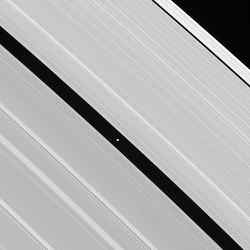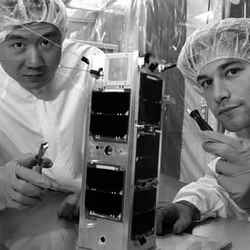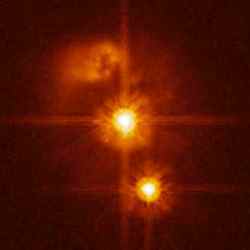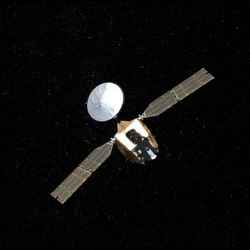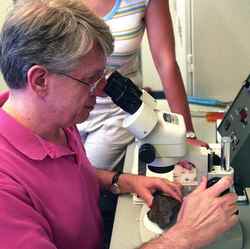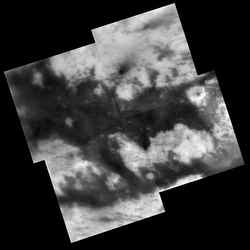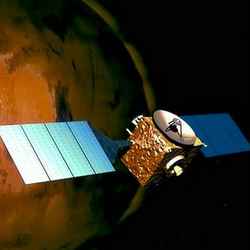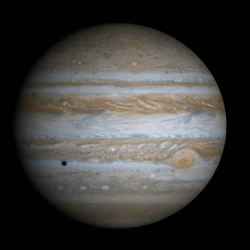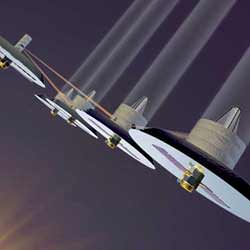
Artist illustration of the Terrestrial Planet Finder. Image credit: NASA/JPL. Click to enlarge.
Find life!
If it were up to me; if I were running NASA, or the ESA, or the plucky Canadian Space Agency, I’d narrow my focus like a laser beam to answer this fundamental question: are we alone in the Universe?
Find life on Mars
At the time that I’m writing this rant, there are two robotic rovers crawling around the surface of Mars searching for evidence that water once existed on Mars. The reasoning is that if Mars was wet for a long period of time, it would have given life an opportunity to get a foothold.
Well, the rovers have done it. Both Spirit and Opportunity have turned up evidence that Mars was warm and wet, probably for millions of years. And although there were supposed last only three months, they’re still going strong after 18 months! Their solar panels are being regularly cleaned by gusts of wind, and it’s not unreasonable to expect many more months of service.
But there’s a problem. The rovers are colour blind. They can analyze rocks, and search for past evidence of water, but they’re unable to see evidence of life. No problem, new equipment is being developed back here on Earth that would give future rovers the ability to analyze soil for the telltale traces of life. Other detectors will be able to sniff the air for a whiff of methane gas; another possible byproduct of life.
Those rovers are so successful, engineers should put future developments on hold and just start mass producing them. Build dozens and equip them with the latest and greatest instruments and turn them loose on the surface of Mars. By mass producing the same rover chassis, engineers should be able to bring the costs down significantly. Keep improving the design, but why reinvent the wheel?
If we could have 20+ rovers on the surface of Mars, sampling soil, sniffing air, and testing ice, from equator to pole, it would substantially improve our chances of finding life. It’s no guarantee, of course, but it would sure give us our best shot to find it. And if you do find life, you could send a second generation of rovers to analyze the life in great detail and learn whether we share a distant ancestor; some adventurous microbe that jumped planets.
The implications of finding life on Mars are staggering; it could mean that life is as pervasive in the Solar System as it is here on Earth. But it might also mean that all life in the Solar System is related, as there’s growing evidence that life can travel back and forth between planets on meteorites.
So, even if we find life on Mars, I think the discovery would be bittersweet. Maybe our Solar System is filled with life, but could the rest of the Universe be lifeless?
Find Life in Other Star Systems
I think it’s fair to say that the Hubble Space Telescope is one of the most productive and important science instruments ever created. It has fundamentally changed our view of the Universe we live in. It helped find extrasolar planets and discovered the mysterious dark energy which is accelerating the Universe.
But to find life on other worlds, we need more specialized tools. One of these is the Terrestrial Planet Finder, which is currently scheduled for launch in 2012-2015. If everything goes as planned, this amazingly sensitive space telescope will be finding Earth-sized planets orbiting other stars within a decade. Furthermore, it’ll be so powerful, it can analyze the atmosphere of these planets and see if any of them have large quantities of oxygen.
That’s critical. We have oxygen in our atmosphere because hardworking microbes and plants have been producing it for millions of years. Oxygen is so reactive, it really can’t exist in the atmosphere unless there’s a constant source refreshing it. So, if you find oxygen, you’ve found life.
So imagine, in just a decade from now, scientists will be able start analyzing nearby stars and turning up planets with biospheres. You could look up in the sky and start pointing out stars to your friends. “Life… life… life.”
Now wouldn’t that be a groundbreaking discovery? Are we alone in the Universe? We might be able to say, “nope, there’s life everywhere.”
I think the Terrestrial Planet Finder is going to be such a fundamental instrument, it’ll become a bottleneck. Scientists will be lined up for 20 years waiting for a shot to use it. We should build more than one. Once again, we should consider “mass producing” them and analyze many planets at once. Bring down the costs, and give scientists a chance to build up a census of the life surrounding us.
But are we talking about intelligent life or slime mold? We won’t really know. (Well, astronomers might figure out how to detect chloroflourocarbons and guess that a planet is in the golden age of air conditioning.)
Until we actually find intelligent life out there, we’re still going to feel a little lonely.
Find Intelligent Life in the Universe
If you’ve seen Contact, you’ll remember Jodie Foster’s character was searching the heavens with a powerful radio telescope, hoping to hear communications from a distant civilization.
This technology exists. For more than 20 years, SETI (Search for Extraterrestrial Intelligence) researchers have been listening to various stars and precise frequencies, hoping to hear a message from afar. The problem is that our Milky Way is an enormous place, with quadrillions of stars. And the number of frequencies are so vast, that it’ll take a long time to search the sky comprehensively.
Technology is improving, and SETI researchers are now able to scan many stars quickly in many frequencies, but it’s still a fraction of the total sky. The computing power to analyze these data is tremendous, but millions of people around the world have installed SETI@home on their personal computers to lend a hand.
Unlike the Mars rovers and various planet finding missions, SETI gets very little public funding. And this is a tragedy. In a single stroke, SETI could discover intelligent life in the Universe, and maybe even help us communicate back. I’d like to watch educational television broadcast by a civilization millions of years more advanced than us.
We need to develop a mega project to scan the entire sky at all the likely frequencies, and even search optical wavelengths too – in case aliens are using lasers to communicate with us.
Find Life: on Mars, on other planets, across the Milky Way.
We live in an amazing time in human history. We’ve wondered about our place in the Universe for thousands of years, and now we’re within arms’ reach of finding the answers. Who knows? Maybe in just a few decades we could have some definitive answers.
And if we don’t find life on Mars, orbiting other stars, or communicating to us across the vast distances of the Milky Way, it’ll tell us something else.
Something just as important.
Maybe life here on Earth is more precious than we thought. We should take better care of the planet we live on, and the creatures we share it with – it might be unique in the Universe.
Let’s start cranking out those rovers, planet finding telescopes and radio dishes and get an answer. (And if I had to choose, I’d probably advocate putting other stuff on hold while we looked).
Written by Fraser Cain


